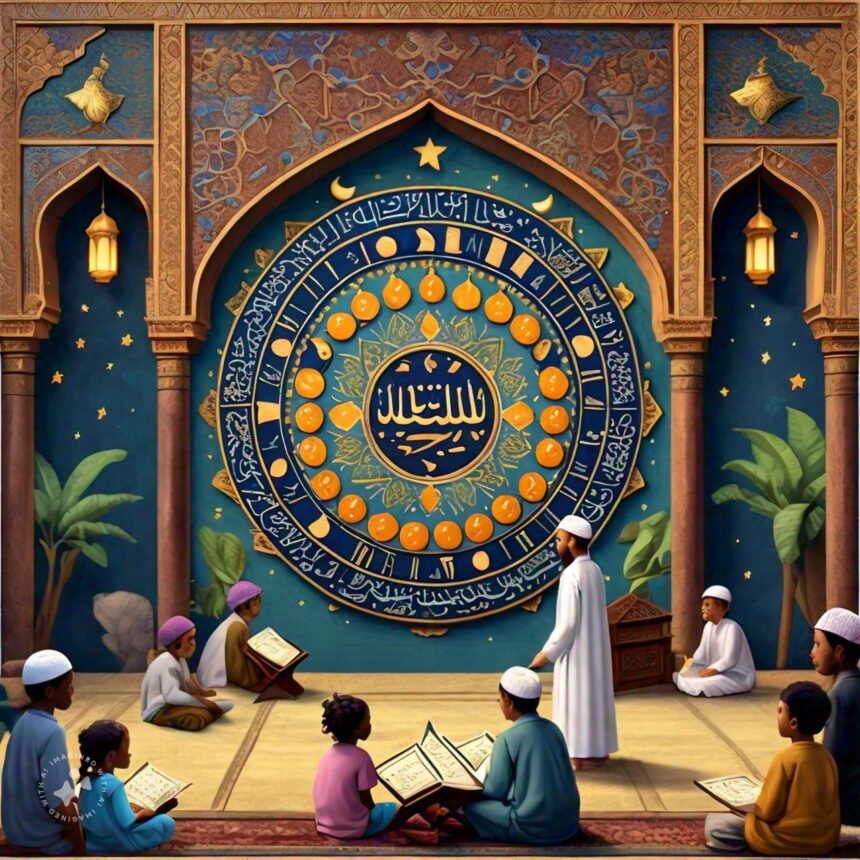The Islamic calendar, also known as the Hijri calendar, is a lunar calendar used by Muslims around the world to determine the dates of religious events and holidays. Unlike the Gregorian calendar, which is solar, the Islamic calendar is based on the cycles of the moon. This article explores the history, names of the Islamic months, and the importance of this calendar in the Muslim world.
History of the Islamic Calendar
The Islamic calendar was established by the second Caliph, Umar ibn Al-Khattab (RA), in 638 CE, during his rule. The calendar starts from the year of the Hijra, the migration of the Prophet Muhammad (PBUH) and his followers from Mecca to Medina in 622 CE. This event, known as the Hijra, marks the beginning of the Islamic era, and thus the calendar is sometimes referred to as the Hijri calendar.
The decision to create an Islamic calendar based on the lunar cycle was significant because it aligned with pre-Islamic Arab customs and ensured the continuity of traditional practices. The lunar calendar consists of 12 months in a year of 354 or 355 days, making it shorter than the solar year by about 10 to 12 days. This discrepancy causes Islamic months to shift approximately 10 days earlier each year in relation to the Gregorian calendar.
Names and Significance of the Islamic Months
The Islamic calendar comprises 12 months, each with its own historical and religious significance. Here is an overview of each month:
- Muharram
Muharram, the first month of the Islamic calendar, is one of the four sacred months in Islam during which warfare is prohibited. The 10th day of Muharram, known as Ashura, is particularly significant. It commemorates the martyrdom of Imam Husayn (RA), the grandson of the Prophet Muhammad (PBUH), at the Battle of Karbala. For Sunni Muslims, Ashura also marks the day when Moses (AS) and the Israelites were saved from Pharaoh’s tyranny.
- Safar
The second month, Safar, is often associated with superstitions and considered unlucky by some, although such beliefs have no basis in Islamic teachings. Historically, Safar was a time when Arab tribes would leave their homes for battles or expeditions.
- Rabi’ al-Awwal
Rabi’ al-Awwal is the third month and holds great significance as it is the birth month of the Prophet Muhammad (PBUH). The 12th day of Rabi’ al-Awwal is celebrated as Mawlid al-Nabi in many Muslim communities, marking the Prophet’s birth and his contributions to humanity.
- Rabi’ al-Thani (Rabi’ al-Akhir)
The fourth month, Rabi’ al-Thani, follows Rabi’ al-Awwal. While it does not have specific events widely celebrated, it remains important within the context of the Islamic lunar year.
- Jumada al-Awwal
Jumada al-Awwal is the fifth month. The name “Jumada” is believed to refer to the dry or parched land during the pre-Islamic era, indicating the time of year it typically fell.
- Jumada al-Thani (Jumada al-Akhir)
Jumada al-Thani is the sixth month, continuing from Jumada al-Awwal. Like its predecessor, it does not have widely recognized religious events but is integral to the lunar cycle.
- Rajab
Rajab is the seventh month and one of the four sacred months in which fighting is forbidden. It is a time for Muslims to prepare for the coming months of heightened spirituality. The 27th day of Rajab is believed by many to mark the night of Isra and Mi’raj, the miraculous night journey and ascension of the Prophet Muhammad (PBUH).
- Sha’ban
The eighth month, Sha’ban, is a time of preparation for Ramadan. The 15th night of Sha’ban, known as Laylat al-Bara’ah or Shab-e-Barat, is observed by some Muslims as a night of forgiveness and prayer.
- Ramadan
Ramadan, the ninth month, is the holiest month in the Islamic calendar. It is the month of fasting, prayer, reflection, and community. During Ramadan, Muslims fast from dawn until sunset, abstaining from food, drink, and other physical needs. The month commemorates the first revelation of the Quran to the Prophet Muhammad (PBUH). Laylat al-Qadr, the Night of Power, which falls within the last ten days of Ramadan, is considered the holiest night of the year.
- Shawwal
Shawwal is the tenth month and begins with the celebration of Eid al-Fitr, marking the end of Ramadan. Eid al-Fitr is a significant festival characterized by communal prayers, feasting, and giving of charity.
- Dhu al-Qi’dah
Dhu al-Qi’dah, the eleventh month, is another of the four sacred months. It is traditionally a time of peace when fighting was suspended. This month precedes the month of Hajj, allowing pilgrims to prepare for the sacred journey to Mecca.
- Dhu al-Hijjah
Dhu al-Hijjah, the twelfth and final month of the Islamic calendar, is the month of the Hajj pilgrimage, one of the Five Pillars of Islam. During this month, millions of Muslims from around the world travel to Mecca to perform the Hajj rituals. The 10th day of Dhu al-Hijjah is Eid al-Adha, the Festival of Sacrifice, commemorating the willingness of Prophet Ibrahim (AS) to sacrifice his son Ismail (AS) in obedience to Allah.
Importance of the Islamic Calendar in the Muslim World
The Islamic calendar plays a crucial role in the religious and cultural life of Muslims worldwide. Here are some key aspects of its importance:
Religious Observances
The Islamic calendar dictates the timing of essential religious observances, including Ramadan, Hajj, and the two Eids (Eid al-Fitr and Eid al-Adha). These events are integral to the spiritual lives of Muslims, fostering a sense of community, devotion, and adherence to Islamic principles.
Cultural Identity
The Hijri calendar is a symbol of Islamic cultural identity and heritage. It connects Muslims to the historical events of early Islam, such as the Hijra, and reinforces the continuity of Islamic traditions. The use of the Islamic calendar in daily life and religious practice helps maintain a distinct cultural identity within the global Muslim community.
Social and Community Life
The Islamic calendar also influences social and community life. Events like weddings, births, and other significant milestones are often planned in accordance with the Hijri months. Community gatherings, charitable activities, and educational programs are often organized around Islamic dates, fostering social cohesion and mutual support.
Global Synchronization
Despite regional and cultural differences, the Islamic calendar provides a unifying framework for Muslims worldwide. Regardless of geographical location, Muslims observe Ramadan, Hajj, and other significant events at the same time, creating a global sense of unity and shared religious experience.
Conclusion
The Islamic calendar, with its rich history and religious significance, is a vital aspect of the Muslim world. Its months mark key religious events and serve as a constant reminder of the spiritual and cultural heritage of Islam. Understanding and appreciating the Islamic calendar not only deepens one’s connection to the faith but also highlights the unity and diversity within the global Muslim community. As we navigate the lunar months, we carry forward the traditions and values that have been cherished by Muslims for centuries.


